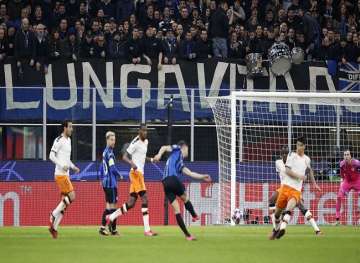Game Zero: It was the biggest soccer game in Atalanta’s history and a third of Bergamo’s population made the short trip to Milan’s famed San Siro Stadium.
Nearly 2,500 fans of visiting Spanish club Valencia also traveled to that Champions League match.
More than a month later, experts are pointing to the Feb. 19 game as one of the biggest reasons why Bergamo has become one of the epicenters of the coronavirus pandemic — a “biological bomb” was the way one respiratory specialist put it — and why 35% of Valencia’s team became infected.
The match, which local media have dubbed “Game Zero,” was held two days before the first case of locally transmitted COVID-19 was confirmed in Italy.
“We were mid-February so we didn’t have the circumstances of what was happening,” Bergamo Mayor Giorgio Gori said this week during a live Facebook chat with the Foreign Press Association in Rome. “If it’s true what they’re saying that the virus was already circulating in Europe in January, then it’s very probable that 40,000 Bergamaschi in the stands of San Siro, all together, exchanged the virus between them. As is possible that so many Bergamaschi that night got together in houses, bars to watch the match and did the same.
“Unfortunately, we couldn’t have known. No one knew the virus was already here,” the mayor added. “It was inevitable.”
Less than a week after the game, the first cases were reported in the province of Bergamo.
At about the same time in Valencia, a journalist who traveled to the match became the second person infected in the region, and it didn’t take long before people who were in contact with him also had the virus, as did Valencia fans who were at the game.
While Atalanta announced its first positive case Tuesday for goalkeeper Marco Sportiello, Valencia said more than a third of its squad got infected, “despite the strict measures adopted by the club” after the match in Milan.
As of Tuesday, nearly 7,000 people in the province of Bergamo had tested positive for COVID-19 and more than 1,000 people had died from the virus — making Bergamo the most deadly province in all of Italy for the pandemic. The Valencia region had more than 2,600 people infected.
Luca Lorini, the head of the intensive care unit at the Pope John XXIII hospital in Bergamo, currently has 88 patients under his care with the coronavirus; not including many more in other parts of the hospital.
“I’m sure that 40,000 people hugging and kissing each other while standing a centimeter apart — four times, because Atalanta scored four goals (the final result was 4-1) — was definitely a huge accelerator for contagion,” Lorini told The Associated Press on Wednesday.
“Right now we’re at war. When peace time comes, I can assure you we will go and see how many of the 40,000 people who went to the game became infected,” Lorini added. “Right now we have other priorities.”
Silvio Brusaferro, the head of Italy’s Superior Institute of Health, said over the weekend at the nightly nationally televised briefing by the civil protection agency that the game was “one of the hypotheses” being evaluated as a source of the crisis in Bergamo.
“It’s certainly an analysis that can be made,” Brusaferro said.
By last week, Bergamo’s cemetery became so overwhelmed by the number of dead that military trucks began transporting bodies to a neighboring region for cremation.
